Making delicious gluten free yeast breads isn’t difficult, it just seems like it ought to be. In fact, in many ways gluten free bread baking is easier and quicker than it is to bake a traditional bread with gluten.
Using the right recipe and the best gluten free ingredients, you don’t even need a loaf pan! Follow my gluten free bread help check list, and these 18 Tips for Gluten Free Bread Baking will bring you delicious gluten free bread baking success!
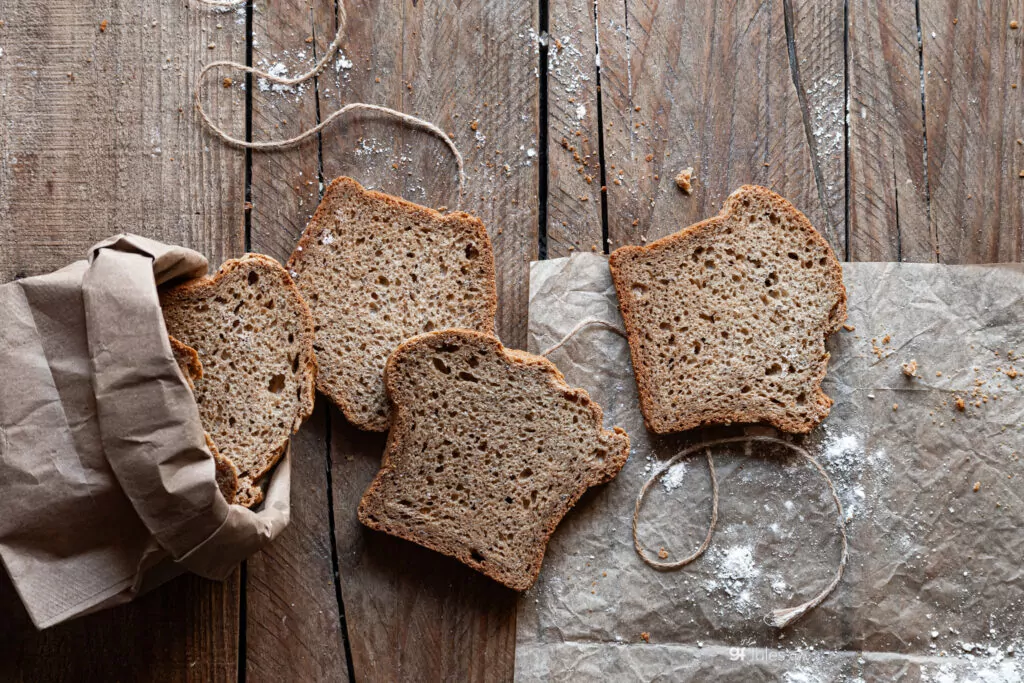
The first rule of thumb is of course to choose your gluten free ingredients wisely, as without this strong foundation, no gluten free bread will be the soft, fluffy, non-sinking loaf we all desire.
My gfJules Gluten Free All Purpose Flour is an excellent choice for all sorts of from-scratch bread baking, my corn-free Multigrain Flour also makes a beautiful loaf of bread, as does my grain-free Nada Flour, but my gfJules Gluten Free Bread Mix is the easiest way to get to bread baking nirvana.
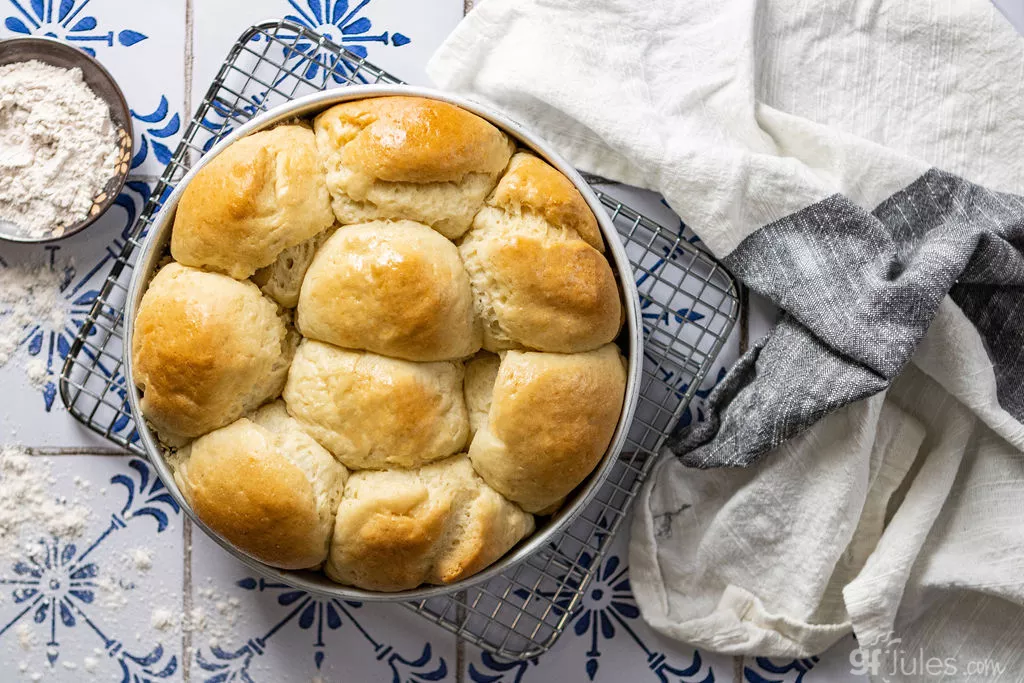
For my tips on baking gluten-free bread in a bread maker, hop to my article here.
For my review of over 10 different gluten free bread makers, hop here.

18 Tips for Gluten Free Bread Baking
1. Don’t scoop flour!
When measuring flour, don’t scoop from the bag with your measuring cup. This can compress the flour — up to 25%! Use a spoon to scoop flour into the measuring cup and level off with a knife instead. Here’s how to measure your gluten free flour properly.
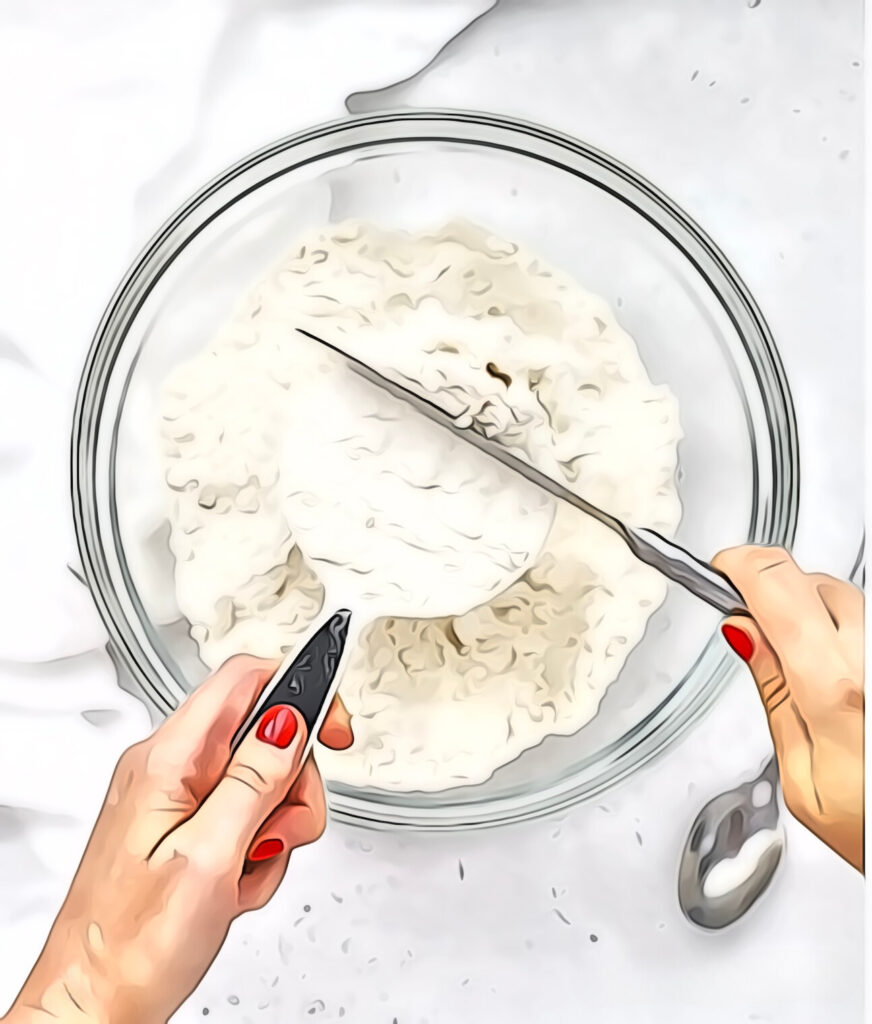
2. Weigh your ingredients.
One step better is to weigh your flour. My gfJules™ All Purpose Gluten Free Flour weighs 135 grams per cup. gfJules Corn-Free Multigrain Biscuit & Breakfast Baking Flour weighs 140 grams per cup. gfJules Nada Flour weighs 110 grams per cup. Make sure you know what the flour you’re using weighs, and if the recipe calls for gram weights as well as cups, go with the proper gram weight per cup of the flour you’re using.
Measuring by weight will ensure that you have the correct amount of flour in any recipe.
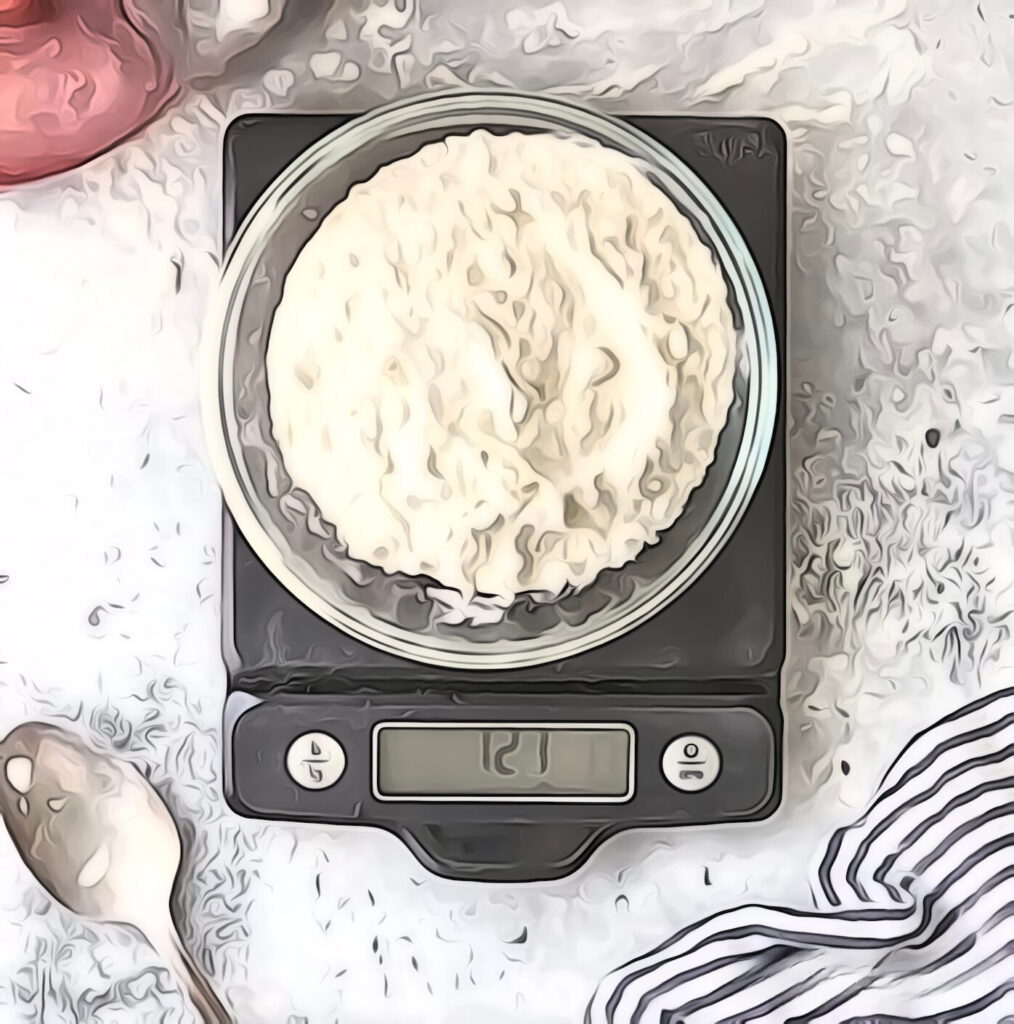
Even 1/2 cup of flour can make a huge difference in the results you get with any recipe. It’s not enough to just use any gluten free flour you choose; gluten free flours aren’t necessarily interchangeable. Follow the flours recommended for each given recipe to get the results promised.
3. Room temperature ingredients make a huge difference!
It is particularly important for yeast recipes that you bring all of your ingredients, such as eggs, to room temperature before adding them together to make bread.
Yeast needs warmth to grow and if your ingredients are too cold, it may prevent full yeast growth. Don’t make your wet ingredients too hot though, just nice and warm, the way yeast likes it! The ideal temperature for yeast to activate is around 100F/38C.
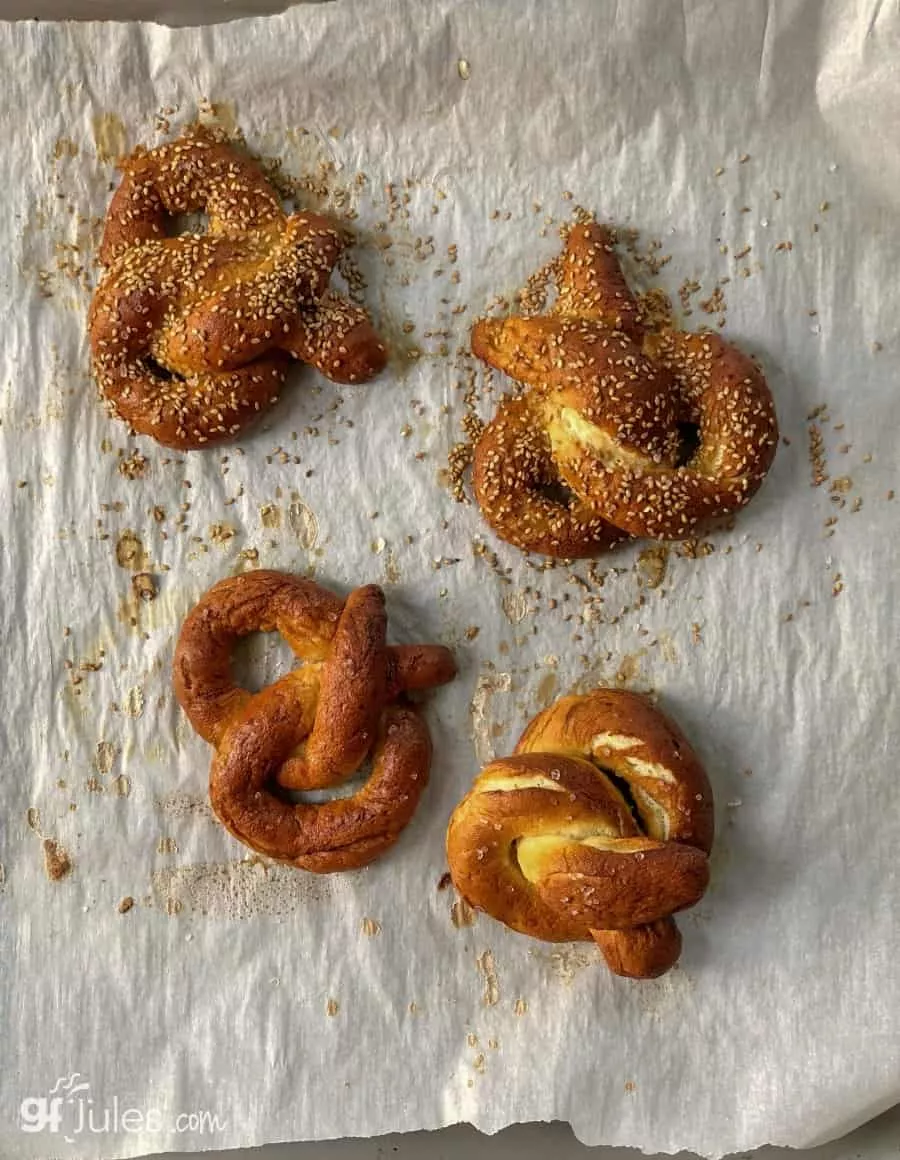
4. When baking gluten free bread, don’t follow directions (for wheat bread).
It is essential when converting wheat-based bread recipes to gluten-free, that you not follow the directions. That’s right! Break all the wheat/gluten dough rules when baking gluten-free bread! Any kneading beyond simply mixing the dough well, and any punching down of the gluten-free dough will punch the risen life right out of it. Those steps are designed to “exercise the gluten” and make it more elastic.
We have no gluten in our recipes, so nothing to exercise, and more than that, these steps will actually cause your gluten-free recipe to fail! It is for this reason that I counsel people when first attempting to make gluten-free breads, to follow a gluten-free bread recipe or two, just to get the hang of it. If you are an accomplished bread baker, it may feel weird for you to abandon these techniques, but trust me, you must!

5. Shape gluten free breads before rising.
Because our gluten free breads have no rise and punch down and second rise and punch down … you’ll want to shape any breads before the rise (they’ll only rise once!).
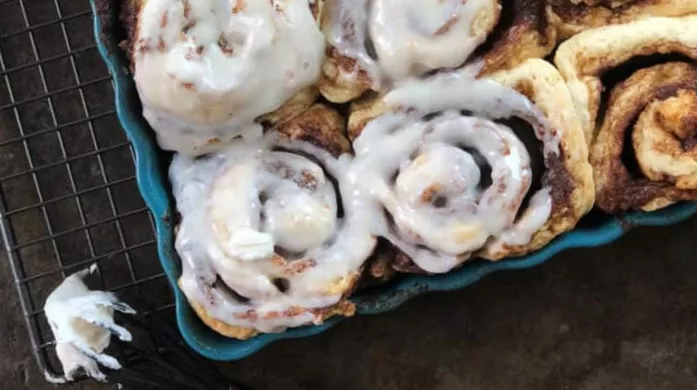
Dinner rolls should rise in the shape or tin you would like them to bake in; bread sticks should be formed before rising; cinnamon rolls should rise in their pans; challah must be braided and then allowed to rise. Don’t mess with gluten-free dough once it has risen, just bake it!
6. High altitude can change the way yeast doughs behave.
Have a look at my High Altitude GF Cooking Tips.
7. Take your gluten free bread’s temperature.
It is very important not to take your bread out of the oven before it is fully cooked. If the bread has a rubbery layer at the bottom, this usually means it was not fully cooked. The best way to tell if the bread is done is to insert an instant read thermometer all the way to the bottom of the loaf (but not touching the pan). The temperature should be approximately 205-210º F when it is done. Your bread should keep its shape when it is completely baked. Internal thermometers are available in my shop.
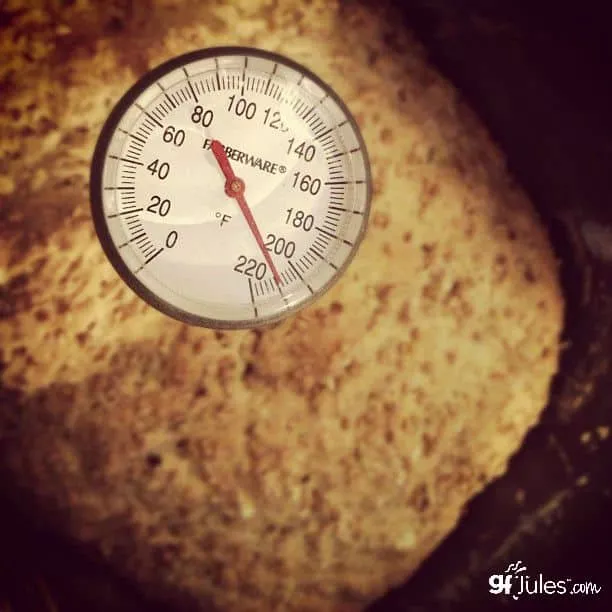
8. Change your bread pan.
Metal pans tend to work better than glass for fully cooking a loaf of bread. Metal pans do not have to be fancy or expensive. Most of my bread recipes work best in 9 x 5 pans, as they are larger volume breads. Stoneware or ceramic pans also bake well.
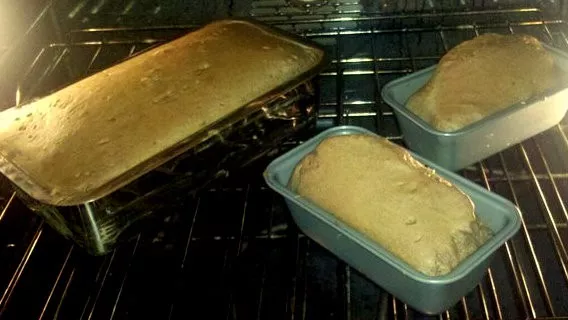
If you’re having trouble with your bread bakes, switch out the pan size or material and see if that makes a difference.
9. Make sure your rising spot is nice and warm.
A great method for letting your yeast breads rise before baking is to turn on your oven to 200º F, then turn it off when it has reached temperature.
Put your un-raised bread into the warmed oven with an oiled piece of parchment on top and a bowl of water in the oven with it, then let it rise according to directions. Once raised, remove the parchment and bake according to directions.
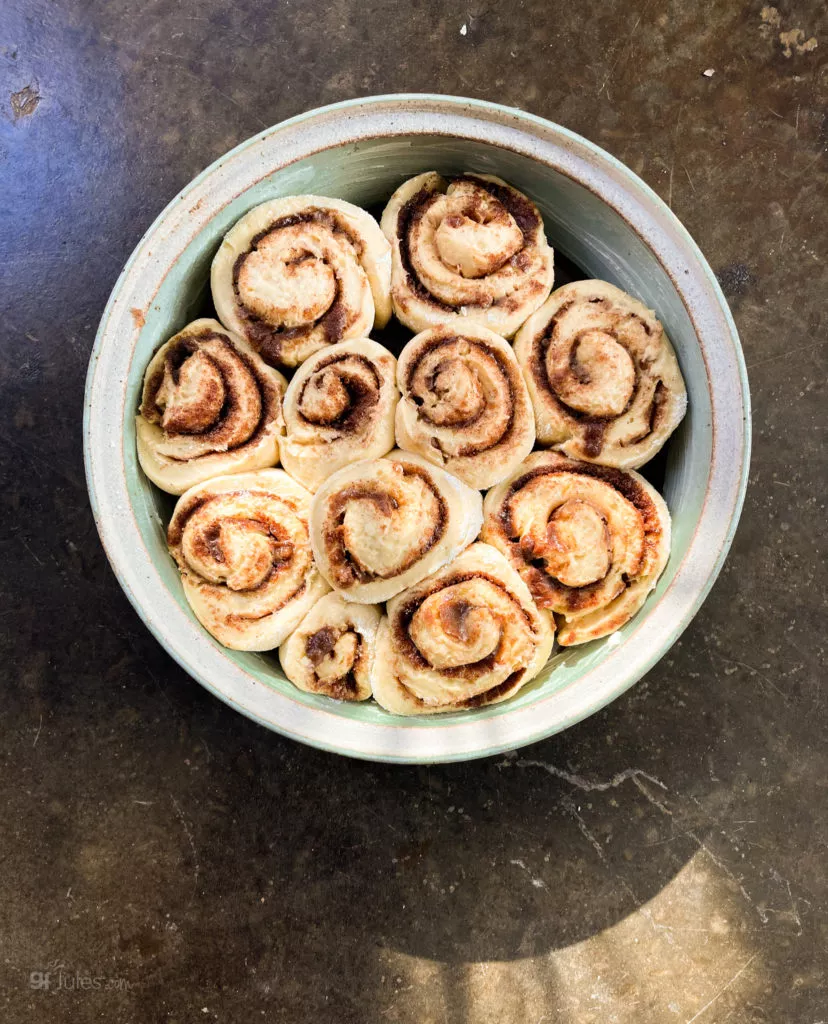
10. Find the perfect rise time and place.
The longer you can let your bread rise, the better it will taste and the less likely it will be to collapse … to a point. A good rule of thumb is to let the bread rise to the top of your pan before baking; a slower, cooler rise to that level will produce a better loaf, so make sure it isn’t rising in too warm of a spot.
If you can let the gluten free bread dough rise overnight in a cool — not warm — place, the slower rise will provide a stronger cell structure and more of a sourdough flavor when baked the next day. A refrigerated overnight rise is a great way to get a longer proof without weakening the bread’s structure.
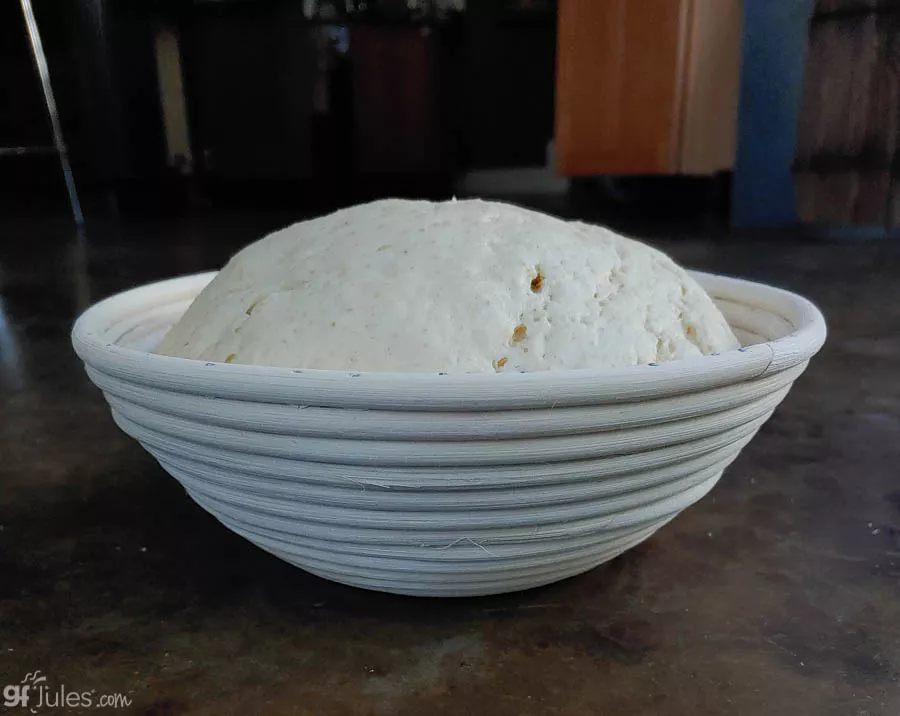
11. Proof your yeast properly.
“Proofed” yeast should look like this. If not, throw it out and start with fresh yeast. (Here’s lots more info on baking with yeast, if you’re interested!)
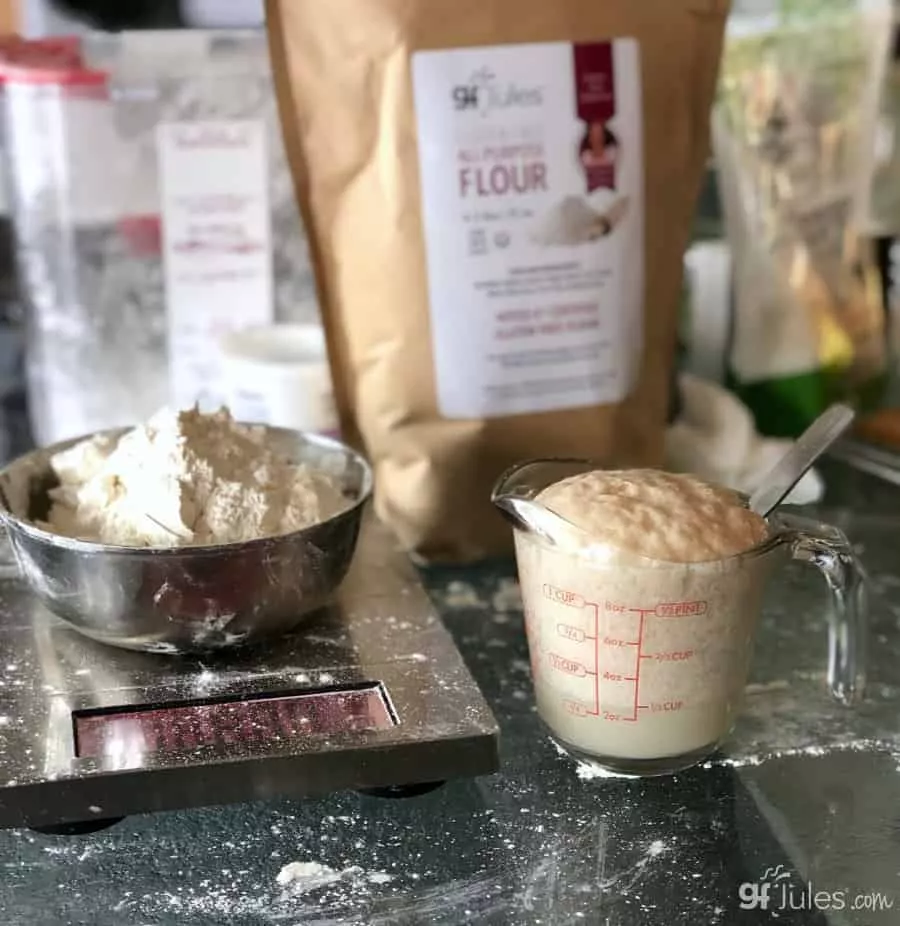
If you’re still having issues with getting your yeast breads to rise, try “proofing” your yeast first. I prefer using “Quick Rise” or “Rapid Rise” yeast for gluten-free yeast breads, but those kinds of yeast should not be proofed — simply add those with your dry ingredients. If you want to try proofing the yeast before adding to the recipe, use regular Active Dry Yeast instead.
Place the yeast in a bowl with the liquid called for in the recipe (water, milk, etc.), but make sure it’s warm. If you can add a teaspoon of sugar, that’s helpful. Whisk it gently and let it sit for 5 minutes. If it’s starting to have that familiar yeasty smell, foam up and swell, it’s good and you can add it to your recipe; if it’s stagnating and not getting foamy or rising, throw it out.
12. Check ingredient integrity.
Yeast can go bad, as can baking soda and baking powder. Sometimes the problem is your ingredients, not you. What a relief, right?
So, how often do you need to replace baking powder and baking soda? As long as the expiration date on each product hasn’t passed, opened cans of baking powder should be used within 3-6 months; opened containers of baking soda should be used within 6 months. I err on the more conservative side of 3 months, and if my baking soda has clumps, I open a new container. Who wants to ruin a recipe just because the leaveners aren’t active enough?
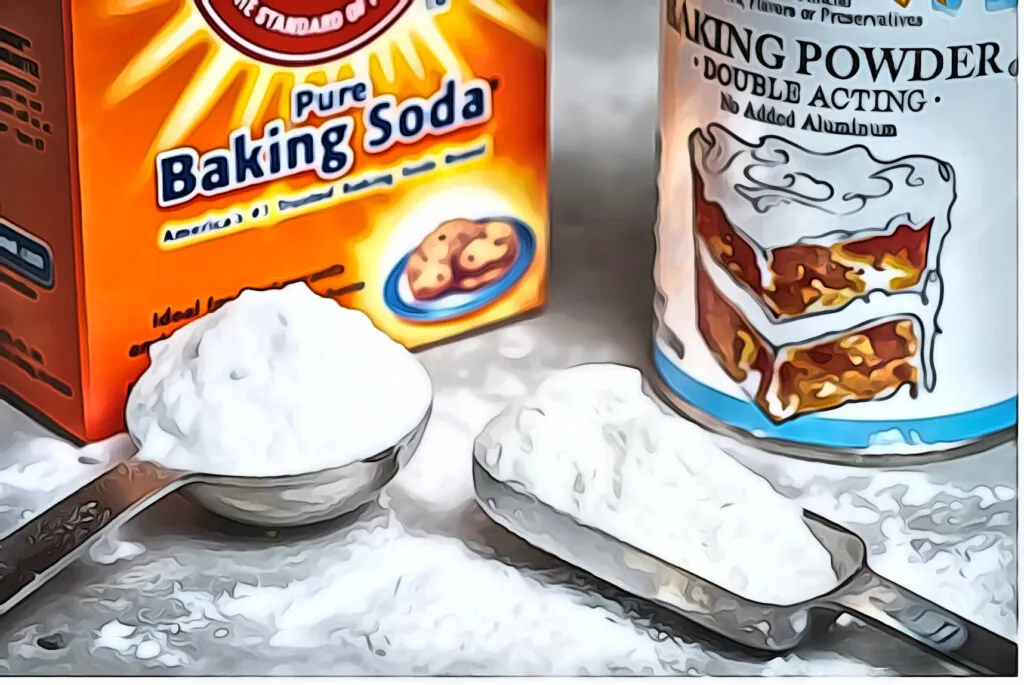
To test whether your leaveners are still active:
How Do I Test Baking Soda?
- Spoon a small amount of baking soda into a bowl
- Add a few drops of lemon juice or vinegar
How Do I Test Baking Powder?
- Spoon a small amount of baking powder into a bowl
- Add hot water
If the mixture fizzes quickly, the baking soda or baking powder will still work well in your recipe. If not, replace it with a fresh container. Use the old box of baking soda in your refrigerator as a deodorizer!
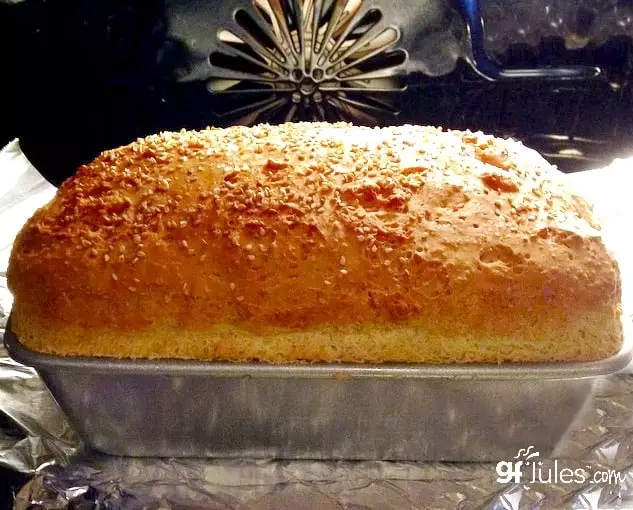
13. Cool bread slowly.
When your bread is done cooking, turn off the oven and open the door so that the bread can cool slowly. Taking the bread out of a hot oven and quickly transferring it to a cool counter can sometimes cause the loaf to sink in.
If it still sinks, it may have too much moisture to support itself fully. It should still taste great, but if you have your heart set on a nice crowned loaf, next time try cutting back on the liquid a bit in that recipe or adding 1/4 cup of flaxseed meal to help support the bread’s structure and enhance its nutritional value, all in one! Altitude and even the day’s weather can affect sometimes-picky yeast recipes.
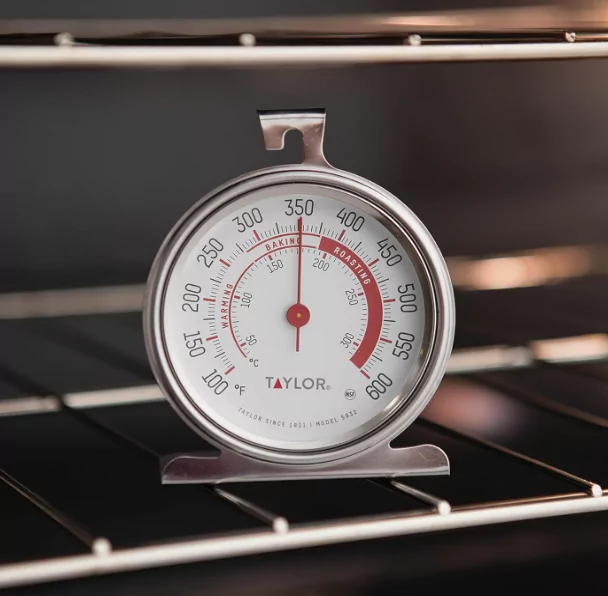
14. Calibrate your oven temperature.
Oven temperatures are frequently off by as little as 25 degrees and it can make a big difference in something as finicky as a yeast bread. Invest in an oven thermometer (they’re less than $10) and adjust your oven’s temperature so your bread will bake comfortably, at the temperature it likes. Here’s how to calibrate your oven without having to call an appliance repair service!
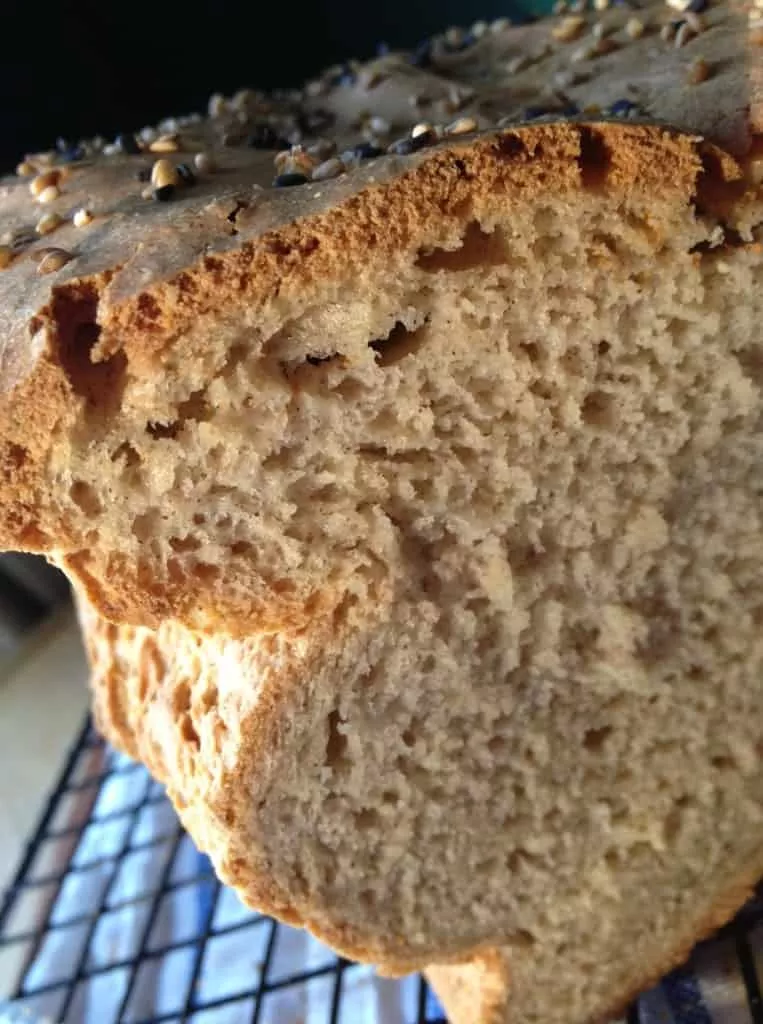
15. Bubbles add air (duh, right?).
It’s amazing what adding bubbles can do for the lift in your bread loaf! Try the same amount of gluten-free beer, ginger ale, 7-Up, Perrier … you get the picture. Room temperature, of course, and measured appropriately (let the bubbles settle for accurate measurements). Check out this gorgeous gluten-free beer bread!
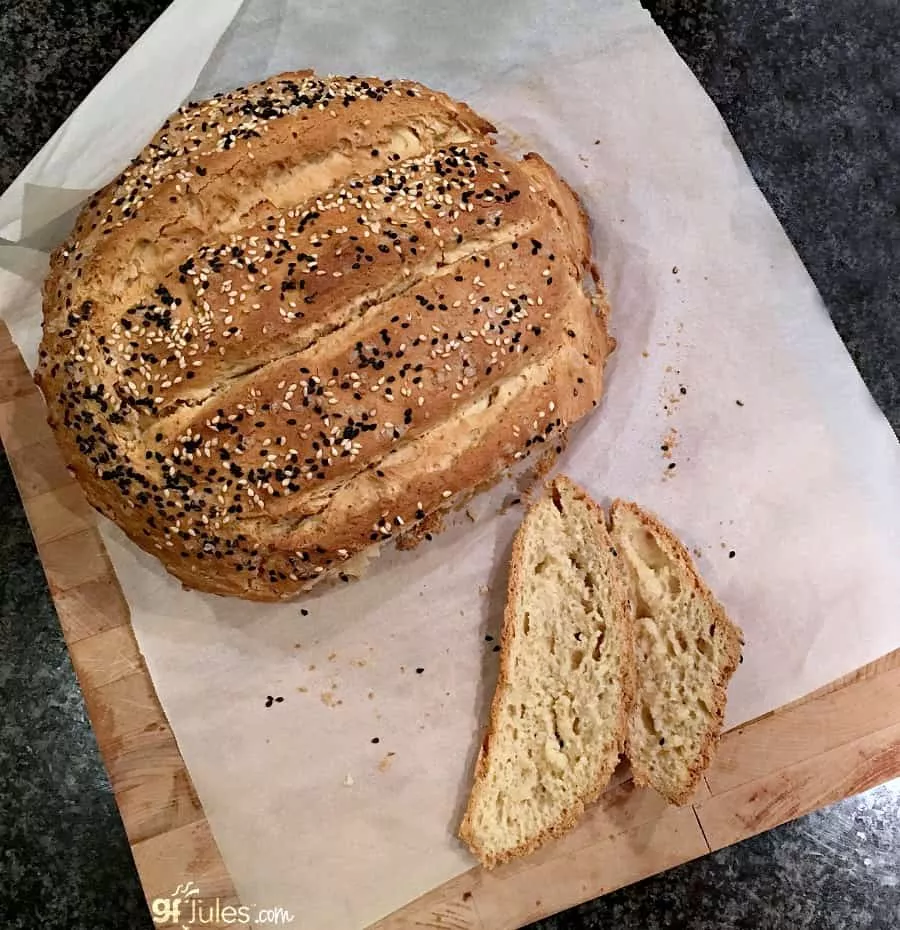
16. Fixing that rubbery bottom.
If you still wind up with a rubbery bottom on your loaf, there are a few things that could have gone wrong.
First, you might have over-beaten the dough. Unlike gluten doughs, gluten-free bread doughs should not be overworked, and doing so can sometimes make them a bit rubbery. Remember NOT TO PUNCH DOWN GLUTEN FREE DOUGHS.
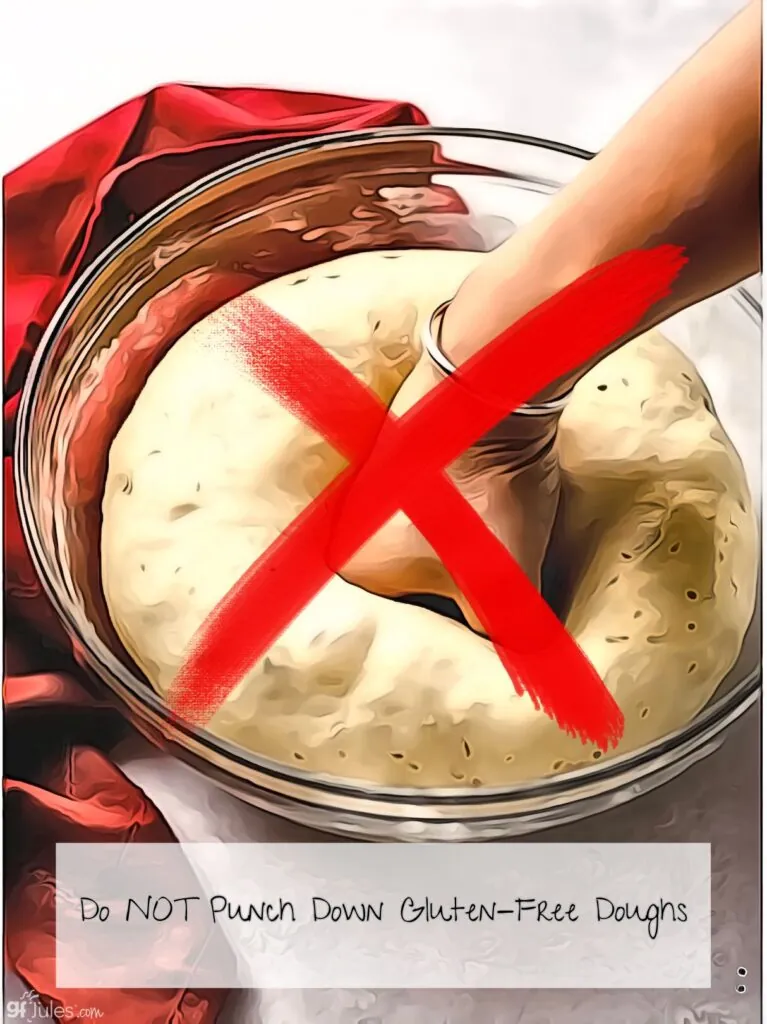
Second, if you are baking from scratch and adding your own xanthan or guar gum, you might have added too much. Find out more about baking with gums in this post.
Third, there might be too much liquid in your recipe, all settling at the bottom and not baking off, while also weighing down the dough. Fourth, the loaf might not have baked all the way. If the top is baked and getting a nice crust, but the bottom isn’t all the way done, cover the loaf with foil and keep baking!
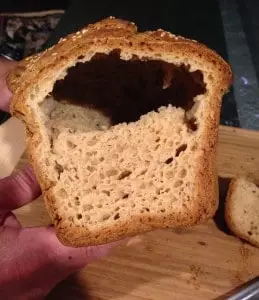
17. Where your loaf is baking also makes a difference.
Too close to the top of the oven, and the top will bake much more quickly than the rest of the bread, causing a split in the loaf. That’s quite a chasm, all because the bread rose so high that it nearly touched the oven’s heating element (and heat rises, don’t forget!). The rack of the oven shouldn’t be so high that the crust is that close to the heating element.
Convection bake settings also help with this, as convection keeps the temperature in the whole oven more consistent. Side note: also be sure there’s not an oven rack above the one on which your bread is baking – you don’t want the bread to rise during the bake and bump into the bottom of another rack!
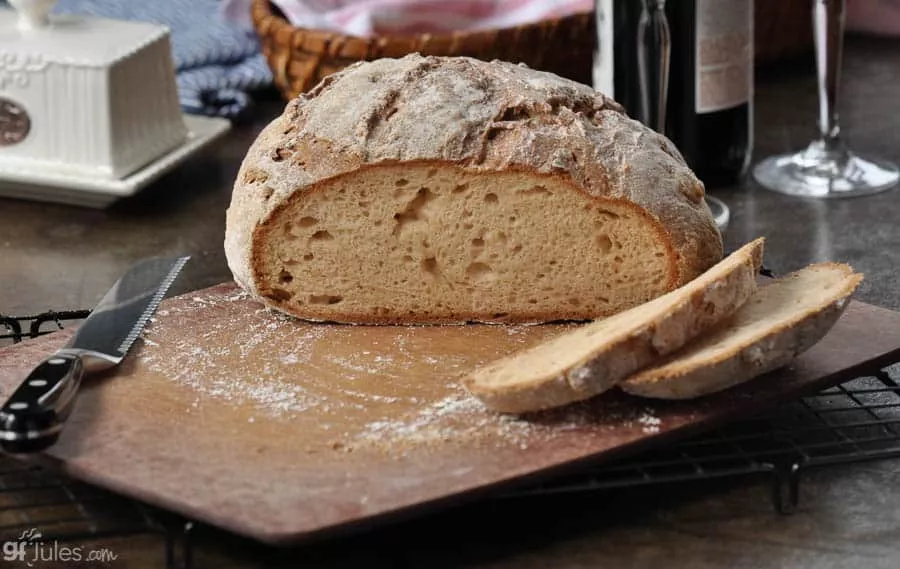
18. You don’t even need a bread pan to make great gluten free bread!
Try making a gluten free artisan loaf on a parchment-lined baking sheet, or baking in a springform or tall-sided oven-safe bowl or pan. Or even use muffin cups or popover trays! Your bread will be yummy no matter how you bake it, if you use the right ingredients!

(Ok, I guess there were more than a couple things …!)
Remember that the gluten free flours you choose ultimately make all the difference, so choose wisely. Then implement these 18 tips for best gluten free bread baking success!
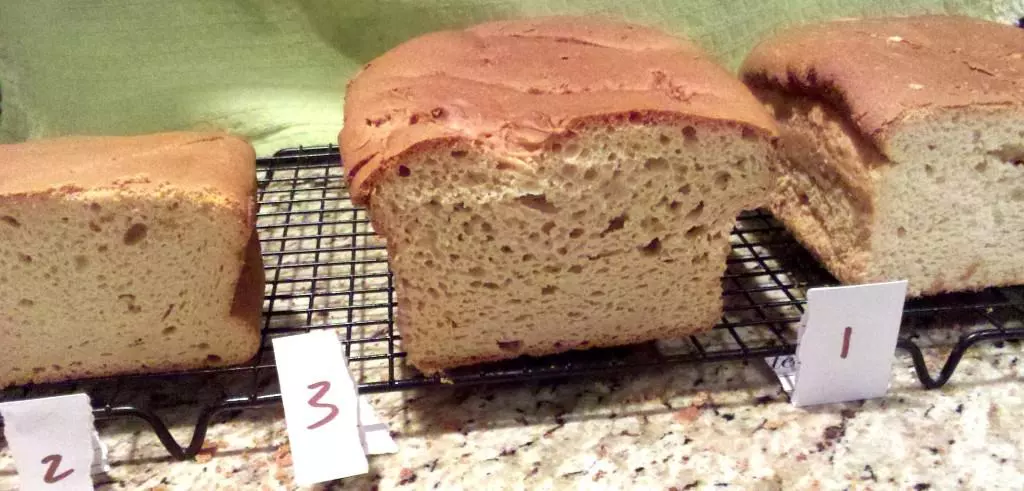
*Note: If you purchase one of these items after following my link, I may receive a small commission, at no additional cost to you, which I use to pay for web design, hosting and services for this blog.
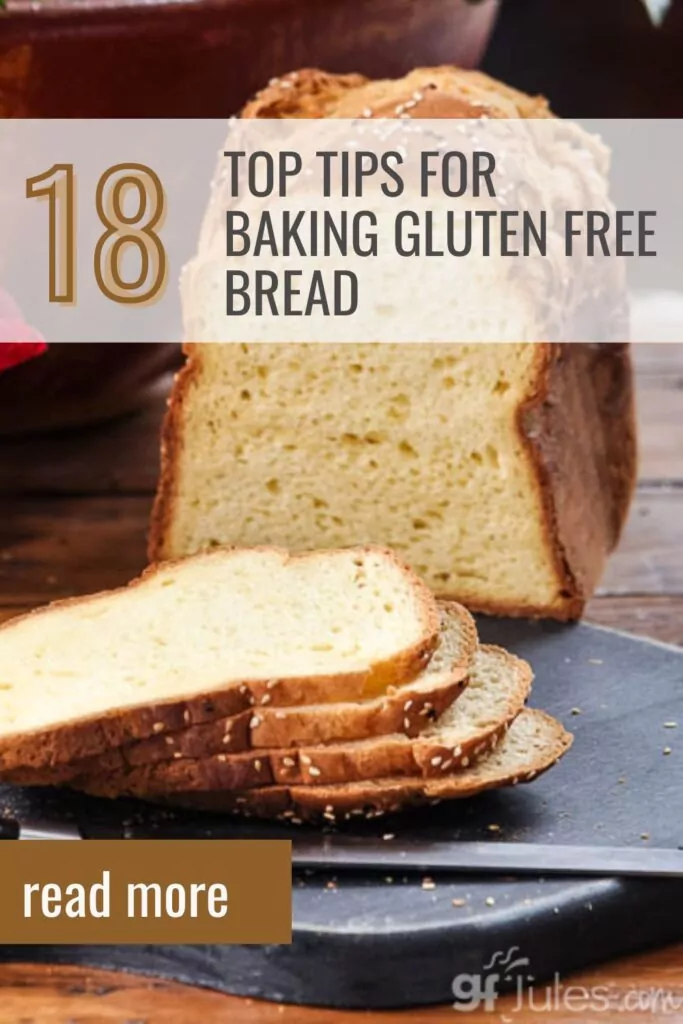
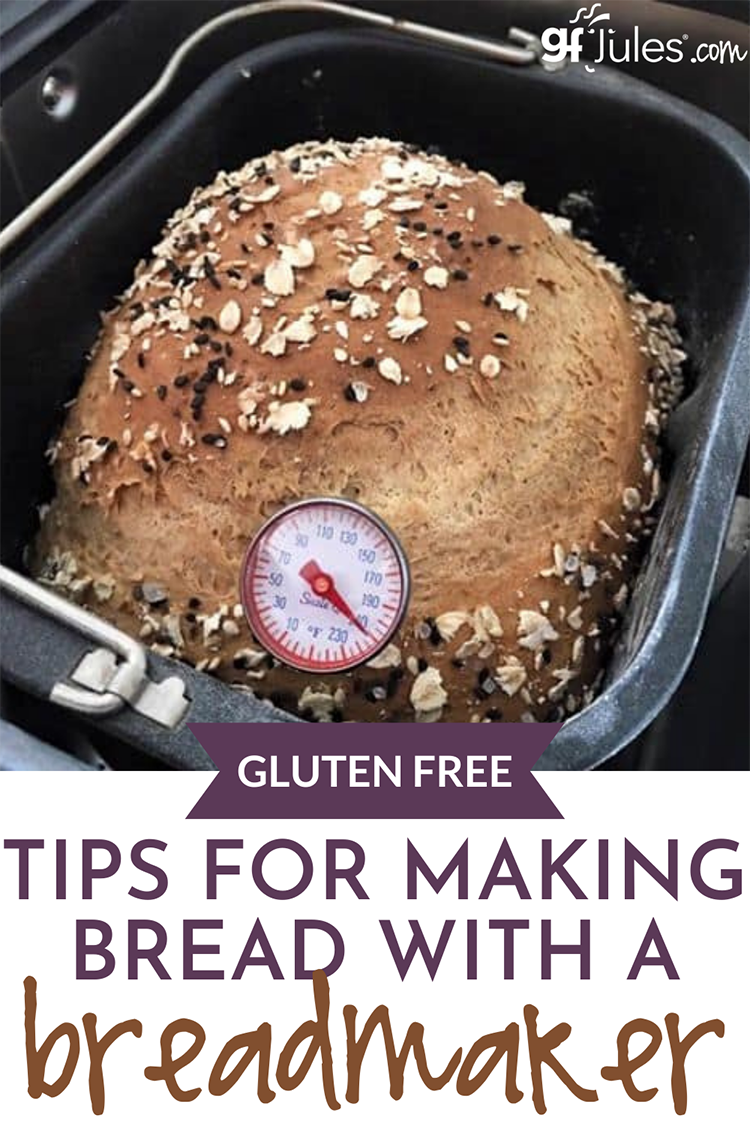



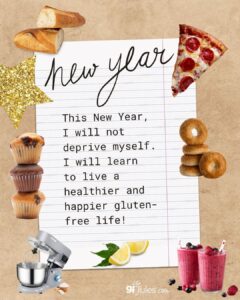
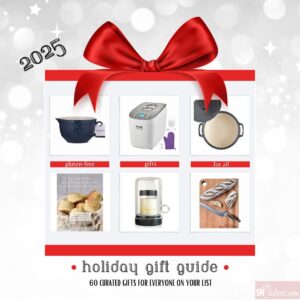
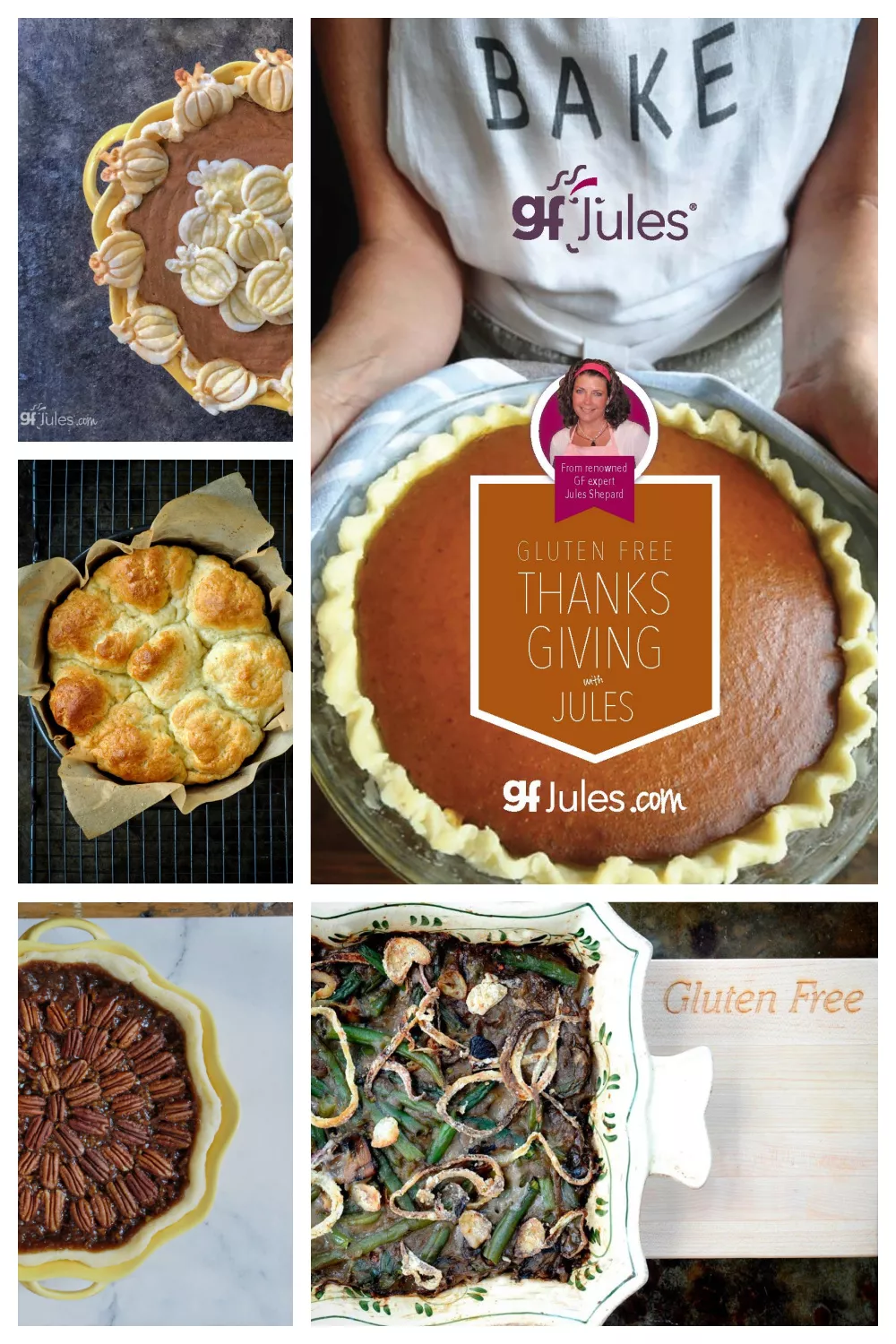


 (25 votes, average: 3.84 out of 5)
(25 votes, average: 3.84 out of 5)
















Thank you so much for all the helpful information .
You are so very welcome!
~jules
Love your gluten free bread recipe and all of the tips!! I am not able to use your blend since i have to avoid corn & potato, but followed your GF sandwich bread recipe and it was delicious!
Wondering whether the recipe can be doubled to make 2 loaves or would that cause issues?
Thanks!!!
Hi Brita, glad you’ve enjoyed success with this recipe! You should be able to double the recipe if your mixer can handle the bulk of two recipes this size. Just make sure the ingredients are well-distributed. Of course, each blend works differently, so take notes and make adjustments as needed for next time. Good luck!
~jules
What kind of add ins can you suggest, such as raisins, cinnamon, banana, etc. I use bob’s red mill GF bread mix?
You can always just toss in your favorite fresh herbs and seeds, or you could use my recipe for gluten free cinnamon raisin bread. Having never used Bob’s Red Mill mix, I can’t comment on how well that will work though. Here’s more information on my gfJules Bread Mix and why it’s so different from all the others.
Hope your bread turns out how you like it!
~jules
All this info is wonderful! I live at 9200′ and have be ‘guesstimating” boiling water temps etc for the last 50 years!
Unfortunately, can’t have corn, rice or potato, so, do you have any suggestions for a bread baking flour? I have become adept at ‘customizing’ and experimenting, but it gets very expensive if the end result is a disaster!
Many thanks for your insights!
I’m so happy this information is helpful to you, Kent! Have a look at my article on gluten free flours for some information on working around those ingredient restrictions.
~jules
Thank you so much for the tips. I have figured out some of this by trouble shooting . Thanks for the confirmation that I am definitely on the right track. Making bread tomorrow for an artisan final. We have to create our own bread using baker’s percentage. I am doing a gluten free load and have been having trouble with the ride. Your tips will help greatly! 😁
Best of luck on your final! Let me know how it goes!!
~jules
jules I am looking for a white bread recipe but not made in a bread machine. i couldn’t find it in all your recipes. can you tell me where to find it?
Hi Fran, you have a few choices. First off, you can always just use my award-winning gfJules Gluten Free Bread Mix. Use milk or bubbly water as the liquid and it will be a white bread flavor and texture with a little yellow color. Otherwise, you can use this recipe for gluten free sandwich bread. Enjoy!
~jules
Hi Jules . I have a problem making gluten free bread I don’t think it rises and when you bake it it turns hard like a rock and it’s kind of goiy inside and no color I baked Swedish bread bread before with no problems so I would like to know what to do. Thank you
Hi May,
It totally depends on the gluten free flours you’re using. Unlike regular gluten bread baking, your results will differ widely, depending on which combo or blend you use. Some gluten free flours are quite heavy and dense, others light and airy. Many gluten free flours suck up moisture at a higher rate than typical flour which will also affect the outcome. Most gluten free flours don’t have a lot of protein, so you’ll want to brush the top of the crust with oil or egg wash to help with color.
Have you tried my gfJules Gluten Free Bread Mix? It’s the easiest, most reliable way to get great gluten free bread: https://shop.gfjules.com/collections/mixes/products/gfjules-gluten-free-sandwich-bread-mix-1-11-lbs
Check out the photos and reviews. I’m betting the poor outcomes you’re used to getting with gluten free bread baking are flour dependent and that this blend will solve your problem!
Hope that helps!
~jules
My bread rises perfectly but tends to become hard while baking. I also don’t get any colour to my bread and it stays unappealingly pale. What could be the cause?
Hi Emma, what kinds of gluten free flours are you using? If the bread gets hard but isn’t fully cooked, then cover with foil.
If you have a convection setting on your oven, that will help it to brown. Also brushing with oil or egg wash will brown the bread.
~jules
My gluten free does not have an oven spring at all. I let it rise till the top of the pan and put it to bake right after. Have even let it rise a bit more but as soon as it goes in to bake, it stops rising while the recipe I followed doubles up in oven. What can i do?
Hi Etka, why don’t you send me the recipe you’re using via email and I’ll take a look. Email me: Jules at gfJules dot com.
~jules
Could you tell me what consistency the dough has to be after you mix it and before letting it rise ? Some recipe say it has to be “wet” and looking like pancake batter ?
Hi Brigitte, it depends entirely on the recipe and the gluten free flours used. You need to rely on the recipe notes for what the dough or batter should look like.
~jules
Do you have a sour dough tip page…will your tips here help with my sour dough as well?
Hi Barbie, yes these tips will help with sourdough as well. Treat the sourdough as you normally would (feeding, sitting out, etc), but use my gfJules Flour. It works really well!
~jules
Thanks so much!! Im trying it today! This will be my 6th attempt at GF sourdough. Your tips are different than the other recipes. So Im excited to try using your tips. Ill let you know how it comes out!.
Great, Barbie! I’m excited to hear how it goes!
~jules
Fix your print option! It would be nice not to print up all the other crap on here, just the essentials.
Thank you for all the useful tips…
You are very welcome, Maria! Happy baking!
~jules
I keep getting bread with a bubble like thenoicture above and I have to toss it. Can I cut across the top of the loaf like you would for regular bread to relieve the air? When would I do this?
Hi Audra, you can open the bread machine after it’s done mixing and slice across the top of the bread to give it natural gaps to rise into. That should help.
~jules
You say “Put your un-raised bread into the warmed oven with an oiled piece of parchment on top and a bowl of water in the oven with it” . . what temperature for the “warmed oven”?
Thanks!
Hi Beau, I usually recommend that folks turn on the oven to 200F and once it’s come to temperature, turn the oven OFF then place the bread dough inside the oven to rise. This is if you don’t have a proofing drawer or somewhere else to set the bread dough to rise in a warm place. Hope that makes sense. Happy bread baking!
~jules
I’m confused because you also say that letting the dough rise without warmth is better….I.e., overnight….? Which metjod is better? I’ve found that I need to let my doughs rise for 6-8 hours to get a real fluffy, authentic bread result.
Hi Sarah, sorry if my options were confusing. There are a few ways of doing it. If you let the dough rise without being in a particularly warm place, and leave it for several hours, it will start to have a more sourdough flavor. It will also rise more slowly, which is good for breads, in general. However, it’s not necessary to do that with gluten free bread, particularly if you’re using instant/quick rise yeast. Does that make sense? Either work should work, but if you’ve already been allowing your breads to rise longer and don’t mind waiting, that should turn out an even better gf loaf. Hope that helps!
~jules
Hello,
I baked gf bread in a Dutch oven on 450 for 90 mins. The color was great yet (used Bob’s 1-1 gf flour, dry active yeast, water, salt) it’s hard like a rock outside and it didn’t cook thoroughly on the inside??
Any tips?
Hi, Thankyou for this very helpful article.
I am using GF bread mix to make bread for a coeliac friend and the loaves look good, rise well, taste OK. Only problem is the sliced bread is slightly sticky to touch. If I leave the bread in the oven to cool after baking maybe that might fix the problem?
I am used to making my own sourdough which I take straight out of the tin to keep the crust from going soft.
I am finding GF bread making quite weird!
Hi Neralie – how generous of you to bake gluten free for your friend! Not knowing exactly what mix you’re using, I’m guessing at what might be the problem, but yes, allowing it to cool before slicing is a good idea. Sometimes gluten free breads can be sticky or rubbery when still warm; once cooled, they settle into their texture and it’s not an issue. Spritz the bread in the oven a few times with water while baking to encourage a crunchier loaf, as well. Best of luck!
~jules
Hi Jules
I need to make a yeast free and gluten free bread. The first one with flax seed didn’t taste great. I am in Europe and don’t have access to your flours. So I used sorghum and spelt flour. Baking powder. Egg whites. Whey protein. Milk. Apple cider vinegar. Butter. Then place it all in a bread machine. The end result is heavy like Cake. Can you assist?
Hi Maria, first off, spelt is NOT gluten free. It is in the wheat family. Otherwise, take a look at this article on gluten free flours and choosing the right combinations: https://gfjules.com/gluten-free-flour-comparison/ Also, check out this article on baking gluten free bread in a bread machine. Hope that helps!
~jules
Hi Jules,
Most of my loaves (except for packaged bread mix but sometimes even those) come out very dense and solid, and heavy. They don’t have any give in them and they don’t taste particularly nice either… so all around, not brilliant. How do I get them to be more fluffy but without them falling apart, like the shop bought ones do?
Best wishes,
Linda
Hi Linda, do you use instant yeast? Do you use carbonated liquid? Are you using a bread machine or oven method? The flours you’re using: are they largely brown rice or other ancient grains? Give me a few more details and I’ll try to help!
~jules
Hi Jules,
Thanks for the helpful tips! I’ve been having a problem with my crusts. I’ve tried 4 or 5 different types of flours (always in the same bread pan), but the crust always turns out hard and almost stale-feeling. The flavor is always great, but the crust is always so hard that it’s a real workout slicing the bread. Any tips for getting a slightly softer crust? Or is a harder crust the name of the game with GF bread?
Hi Tom, have you tried my gfJules Bread Mix? When baked with an aluminum foil tent, it doesn’t tend to get so crusty. Also, use a lighter metal pan for less of a crust. I hope those tips help!
~jules